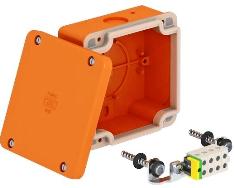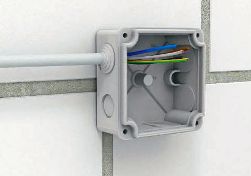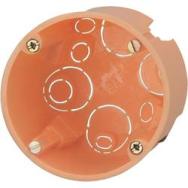Categories: Featured Articles » Electrician at home
Number of views: 107896
Comments on the article: 2
Junction Boxes for Home Wiring
Branch Box Functions
 With a switch, light or socket, each electrician searches for the shortest path to the nearest branch box. This is understandable: I want to save on the cable, and nobody wants to do the extra work on laying it. Therefore, boxes in each apartment are usually enough: up to two or three in one room.
With a switch, light or socket, each electrician searches for the shortest path to the nearest branch box. This is understandable: I want to save on the cable, and nobody wants to do the extra work on laying it. Therefore, boxes in each apartment are usually enough: up to two or three in one room.
But still, the main purpose of branch boxes is not to save materials and working time. Their most important function is to protect the cable core connections from external influences: from dust, moisture and mechanical damage.
In fact, whatever we take to wire core connections, all the same, the places of these connections look so defenseless - the factory insulation is stripped, both internal and external, and the integrity of the conductors is broken. Of course, without proper protection, dust or moisture can block the connections and a short circuit will occur. Or, from mechanical damage, on the contrary, it will increase noticeably transition resistance, and the quality of the contact will decrease.
 In both cases, the consequences will be unpleasant, therefore junction boxes just necessary. In addition, they are needed according to the requirements of aesthetics, since they close the unsightly ends of the wires and terminal blocks or PPE caps.
In both cases, the consequences will be unpleasant, therefore junction boxes just necessary. In addition, they are needed according to the requirements of aesthetics, since they close the unsightly ends of the wires and terminal blocks or PPE caps.
Types of junction boxes
Junction boxes have been used for a very long time and have undergone many evolutions. There were boxes for hollow walls, boxes with a contact group, square boxes, boxes for open and hidden wiring. Let's try to figure out all this diversity.
It all started, of course, with junction boxes for outdoor wiring - ordinary round glasses of thin metal, closed with the same lid. These boxes fulfill their function: they are relatively tight and do not burn. And to this day they can be seen in some houses of the old construction. Sometimes instead of such boxes used ... ordinary tin cans. For hidden wiring, the same metal glasses were used, walled up in the walls.
Metal junction boxesOf course, they are durable and are used even today, however, mainly in industry. But still, metal is an expensive material, and spending it on boxes is not always advisable. In addition, working with metal is not easy: it is difficult to make additional introduction holes if necessary, and it is difficult to increase their diameter.
Therefore, with the development of new plastic materials appeared plastic junction boxeswhich are the most popular today: they are made of impact-resistant plastic that does not support combustion. These boxes are divided into boxes for concealed and for open wiring.
Junction boxes for open wiring come in a variety of sizes, because often a large number of wires are connected in one box, and a traditional small box may simply not be enough. Large branch boxes, as a rule, are square in shape and have several standard cable entries on each side.
 The openings of the branch boxes for open wiring are closed either with plastic plugs that must be broken out or with rubber glands that are cut to size corrugated pipes or cable. Inputs of round boxes are supplemented with "horns" - sleeves of a special shape made of the same plastic and contributing to tight installation. Therefore, round boxes for open wiring are classified into “three-arm” and “four-arm” - according to the number of possible branches.
The openings of the branch boxes for open wiring are closed either with plastic plugs that must be broken out or with rubber glands that are cut to size corrugated pipes or cable. Inputs of round boxes are supplemented with "horns" - sleeves of a special shape made of the same plastic and contributing to tight installation. Therefore, round boxes for open wiring are classified into “three-arm” and “four-arm” - according to the number of possible branches.
For open wiring in plastic boxes, some manufacturers produce special junction boxes that are combined with the box in color and design. Such boxes greatly simplify installation.
The covers of the boxes for open wiring are mounted either on screws or on their own thread with a large pitch (if the box is round), or the cover is simply put on tightly. During installation, it is important not to lose the cover while the cable is forwarded and the ends are connected, because it is not always possible to find another box that is exactly the same, and the covers are not sold separately at all. Therefore, boxes are produced, the covers of which always hang with them on a separate bundle of soft plastic.
 Junction boxes for concealed wiring, in turn, there are also two types: for solid and for hollow walls. And those and others also come in both round and square shapes. And they also have the most diverse sizes. But boxes designed for mounting in a hollow wall, for example in a plasterboard partition, have one design feature: presser feet on long screws.
Junction boxes for concealed wiring, in turn, there are also two types: for solid and for hollow walls. And those and others also come in both round and square shapes. And they also have the most diverse sizes. But boxes designed for mounting in a hollow wall, for example in a plasterboard partition, have one design feature: presser feet on long screws.
The hole in the partition is cut exactly to the size of the box, and the legs pull it to the partition from the inside. From above, this case is closed with a lid (most often with screws). Branch boxes for concealed electrical wiring in solid walls do not have any paws - they are simply fastened in a pre-prepared hole in the wall with alabaster or other quick-drying mortar.
Instead of boxes for hidden wiring, often use the appropriate socketshaving come up with some homemade covers for them. In fact, this does not contradict any rules, since the undergrowth is carried out according to the same requirements of tightness, strength and incombustibility. If only the cover was also reliable in this respect.
The method of connecting the conductors of wires and cables in any branch box is usually left to the choice of an electrician. But there are boxes with a contact group. They keep inside ready terminal block, e.g. ZVI. It is difficult to judge how convenient this is. First of all, after all, the terminal strip rating on the current load is limited, and the number of places is also small. Therefore, sometimes you have to remove the terminal block and take on the good old PPE.
With contact groups, some special types of junction boxes are also available, for example, boxes for communication lines. Sometimes they are also used for installation of household wiring. This categorically cannot be done: they simply are not intended for serious current load.
Installation of junction boxes
 There are some vowels and unspoken rules regarding the installation of junction boxes. First of all, since the wiring lines stretch under the ceiling or at a height of 2.5 meters, then the boxes are usually located there, so as not to waste extra meters of cable.
There are some vowels and unspoken rules regarding the installation of junction boxes. First of all, since the wiring lines stretch under the ceiling or at a height of 2.5 meters, then the boxes are usually located there, so as not to waste extra meters of cable.
However, you should always remember that access to the box must remain constant throughout the operation of the wiring. Therefore, if, for example, cable lines are stretched behind a stretch ceiling, then the boxes should be placed below the level of this ceiling so that they do not close. The ends of the cables, respectively, should be brought down to the boxes. This is not very convenient during installation, but the person who will have to repair and maintain this line will be grateful to you.
The box itself after installation should remain intact, not burst. The lid on it should sit tight and securely, therefore, it should not be excessively clogged with cable cores - it is better to replace it with a larger box or install another, additional box.
Repair and modernization of electrical wiring almost impossible without opening the branch boxes, and therefore, during installation, it is necessary to draw up a plan for the location of the boxes with an indication of their number and the purpose of the lines that enter into them.First of all, this applies to boxes for hidden electrical wiring, which are sometimes completely covered with wallpaper or plaster. Of course, to close the boxes with tiles or to block them with any structures should not be for the same reasons of accessibility.
Alexander Molokov
See also at bgv.electricianexp.com
:
